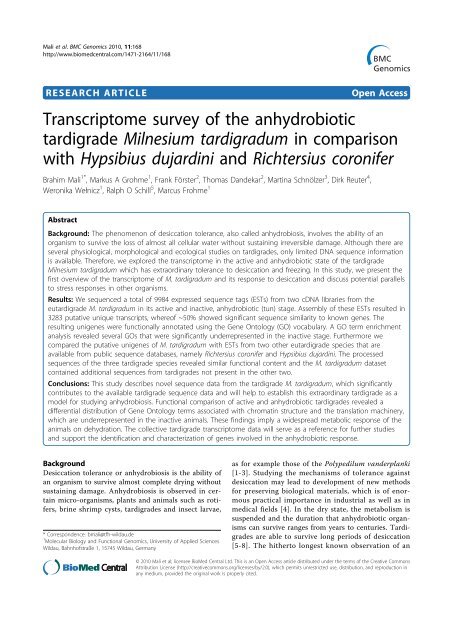Making the most of phylogeny - OPUS - Universität Würzburg
Making the most of phylogeny - OPUS - Universität Würzburg
Making the most of phylogeny - OPUS - Universität Würzburg
Create successful ePaper yourself
Turn your PDF publications into a flip-book with our unique Google optimized e-Paper software.
Mali et al. BMC Genomics 2010, 11:168<br />
http://www.biomedcentral.com/1471-2164/11/168<br />
RESEARCH ARTICLE Open Access<br />
Transcriptome survey <strong>of</strong> <strong>the</strong> anhydrobiotic<br />
tardigrade Milnesium tardigradum in comparison<br />
with Hypsibius dujardini and Richtersius coronifer<br />
Brahim Mali 1* , Markus A Grohme 1 , Frank Förster 2 , Thomas Dandekar 2 , Martina Schnölzer 3 , Dirk Reuter 4 ,<br />
Weronika Wełnicz 1 , Ralph O Schill 5 , Marcus Frohme 1<br />
Abstract<br />
Background: The phenomenon <strong>of</strong> desiccation tolerance, also called anhydrobiosis, involves <strong>the</strong> ability <strong>of</strong> an<br />
organism to survive <strong>the</strong> loss <strong>of</strong> al<strong>most</strong> all cellular water without sustaining irreversible damage. Although <strong>the</strong>re are<br />
several physiological, morphological and ecological studies on tardigrades, only limited DNA sequence information<br />
is available. Therefore, we explored <strong>the</strong> transcriptome in <strong>the</strong> active and anhydrobiotic state <strong>of</strong> <strong>the</strong> tardigrade<br />
Milnesium tardigradum which has extraordinary tolerance to desiccation and freezing. In this study, we present <strong>the</strong><br />
first overview <strong>of</strong> <strong>the</strong> transcriptome <strong>of</strong> M. tardigradum and its response to desiccation and discuss potential parallels<br />
to stress responses in o<strong>the</strong>r organisms.<br />
Results: We sequenced a total <strong>of</strong> 9984 expressed sequence tags (ESTs) from two cDNA libraries from <strong>the</strong><br />
eutardigrade M. tardigradum in its active and inactive, anhydrobiotic (tun) stage. Assembly <strong>of</strong> <strong>the</strong>se ESTs resulted in<br />
3283 putative unique transcripts, where<strong>of</strong> ~50% showed significant sequence similarity to known genes. The<br />
resulting unigenes were functionally annotated using <strong>the</strong> Gene Ontology (GO) vocabulary. A GO term enrichment<br />
analysis revealed several GOs that were significantly underrepresented in <strong>the</strong> inactive stage. Fur<strong>the</strong>rmore we<br />
compared <strong>the</strong> putative unigenes <strong>of</strong> M. tardigradum with ESTs from two o<strong>the</strong>r eutardigrade species that are<br />
available from public sequence databases, namely Richtersius coronifer and Hypsibius dujardini. The processed<br />
sequences <strong>of</strong> <strong>the</strong> three tardigrade species revealed similar functional content and <strong>the</strong> M. tardigradum dataset<br />
contained additional sequences from tardigrades not present in <strong>the</strong> o<strong>the</strong>r two.<br />
Conclusions: This study describes novel sequence data from <strong>the</strong> tardigrade M. tardigradum, which significantly<br />
contributes to <strong>the</strong> available tardigrade sequence data and will help to establish this extraordinary tardigrade as a<br />
model for studying anhydrobiosis. Functional comparison <strong>of</strong> active and anhydrobiotic tardigrades revealed a<br />
differential distribution <strong>of</strong> Gene Ontology terms associated with chromatin structure and <strong>the</strong> translation machinery,<br />
which are underrepresented in <strong>the</strong> inactive animals. These findings imply a widespread metabolic response <strong>of</strong> <strong>the</strong><br />
animals on dehydration. The collective tardigrade transcriptome data will serve as a reference for fur<strong>the</strong>r studies<br />
and support <strong>the</strong> identification and characterization <strong>of</strong> genes involved in <strong>the</strong> anhydrobiotic response.<br />
Background<br />
Desiccation tolerance or anhydrobiosis is <strong>the</strong> ability <strong>of</strong><br />
an organism to survive al<strong>most</strong> complete drying without<br />
sustaining damage. Anhydrobiosis is observed in certain<br />
micro-organisms, plants and animals such as rotifers,<br />
brine shrimp cysts, tardigrades and insect larvae,<br />
* Correspondence: bmali@tfh-wildau.de<br />
1 Molecular Biology and Functional Genomics, University <strong>of</strong> Applied Sciences<br />
Wildau, Bahnh<strong>of</strong>straße 1, 15745 Wildau, Germany<br />
as for example those <strong>of</strong> <strong>the</strong> Polypedilum vanderplanki<br />
[1-3]. Studying <strong>the</strong> mechanisms <strong>of</strong> tolerance against<br />
desiccation may lead to development <strong>of</strong> new methods<br />
for preserving biological materials, which is <strong>of</strong> enormous<br />
practical importance in industrial as well as in<br />
medical fields [4]. In <strong>the</strong> dry state, <strong>the</strong> metabolism is<br />
suspended and <strong>the</strong> duration that anhydrobiotic organisms<br />
can survive ranges from years to centuries. Tardigrades<br />
are able to survive long periods <strong>of</strong> desiccation<br />
[5-8]. The hi<strong>the</strong>rto longest known observation <strong>of</strong> an<br />
© 2010 Mali et al; licensee BioMed Central Ltd. This is an Open Access article distributed under <strong>the</strong> terms <strong>of</strong> <strong>the</strong> Creative Commons<br />
Attribution License (http://creativecommons.org/licenses/by/2.0), which permits unrestricted use, distribution, and reproduction in<br />
any medium, provided <strong>the</strong> original work is properly cited.

















